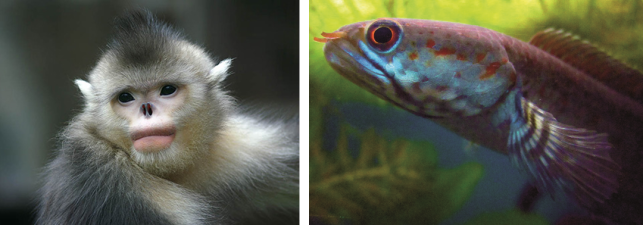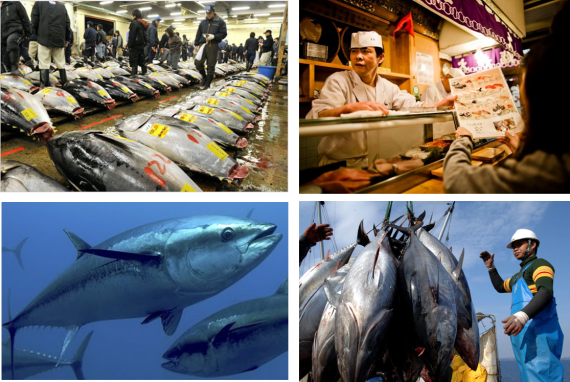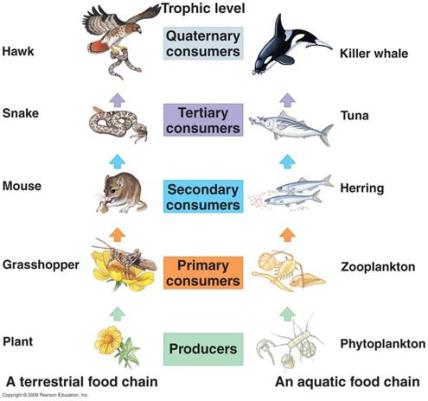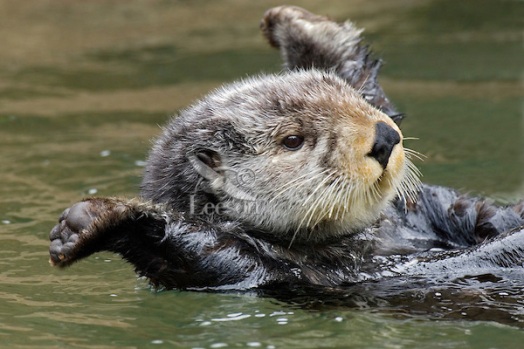According to the World Wildlife Fund, since 2009, 211 new species have been discovered in the Eastern Himalayas. Two such species are that of a fish that can breathe air for up to four days and wriggle its way between water sources, plus a monkey nicknamed ‘snubby’ who, locals say, can be heard sneezing during rainy days due to the entrance of water into its upturned nose.
Despite being one of the most biodiverse places on Earth, only around 25% of the Himalayas’ original habitats remain intact, threatening many of the species that live there. One such species is the snow leopard, whose population nw dwindles between a meager 4,000 and 6,000, leading to its classification of endangered under the IUCN red list. Sadly, the discovery of new species in the Himalayas is not representative of the global picture as a whole. The worldwide rate of species loss is estimated to be between 1,000 and 10,000 times higher than the natural extinction rate, i.e. the rate of extinction that would naturally occur without human interference. This means that if the upper estimate of species numbers is true, then between 10,000 and 100,000 species become extinct every year, partly or wholly due to human causes.
We see examples of this loss everywhere around the globe. Although holding an important part in the marine ecosystem as a top predator, the Bluefin tuna has been overfished to such an extent that the Pacific Ocean tuna has suffered a 96% decline in stock levels. Considered an endangered species, 90% of the specimens caught are too young to have had the chance to reproduce, meaning they may be the last generation of Bluefin tuna. The flesh of the Bluefin is highly valued amongst sushi restaurants in Japan, where 80% of the global catch is consumed. Conservation groups have called for a complete ban on the fishing of Bluefin tuna in order to allow stocks to be replenished, however no agreement has been reached between governments, partly due to the economic and social value of the fish.
In South Africa, poachers kill more than a thousand white rhinos annually and in November this year, the death of Nola the Northern White Rhinoceros meant that there are only three members of her subspecies left on Earth. The Western Black Rhino has been officially extinct since 2011, the primary cause identified as poaching. In Taiwan, the Formosan clouded leopard is now classified as extinct due to the loss of its habitat and prey, poaching for its meat, bones and pelt (skin), and as a result of retaliation from native farmers whose livestock the cats sometimes preyed upon. Deforestation was a major contributing factor towards the extinction of the species due to the increasing need for human living space and timber. According to some scientists, we are now facing what could be the sixth extinction crisis. The current extinction challenge is particularly disturbing as, unlike the previous five mass extinction events within Earth’s geological history, the current crisis is one for which a single species is solely responsible – humans.
What is biodiversity and how does a loss of species affect it?
As identified above there are many species on the planet at risk of becoming, or have already become, extinct due to the actions of humankind, thereby threatening the biodiversity of the Earth. Biodiversity is a term used to describe not only the amount of species within an ecosystem but also the variety. It is a way of measuring and reflecting the healthiness of ecosystems, within which every single living organism has a role and a function. The human population relies on a healthy environment for the provision of what scientists call ecosystem services, in other words, the benefits obtained by humans from ecosystems. These can include the provision of food, water and timber for shelter, but also services such as the purification of water, soil nutrient recycling and regulation of the climate. Without a healthy ecosystem, humans suffer the consequences. Under current statistics, the global human population is currently using around 25% more natural resources than the planet can comfortably sustain and as a result, ecosystems are under increasingly more stress to replace what is being removed.
What is this doing to the planet?
The overexploitation of the planet’s resources is currently at a highly unsustainable level; The Living Planet Index shows that since 1970, there has been a 52% decline in global biodiversity levels.
Collapse of the Newfoundland Cod Fishery:
During the 1950s, the Newfoundland cod fishing grounds were some of the most productive in the world. In 1968 the cod catch peaked at 800,000 tonnes, but little more than seven years later the annual catch had fallen by 60%. Technological developments during the 1960s allowed fisherman to trawl for longer, covering larger areas and deeper waters. As such, the rate at which the cod was removed from the sea was much higher than sustainable levels and the fish that remained found less food available, as their main source of prey, capelin, were also hauled as bycatch. In 1992 the Canadian government was forced to implement a moratorium (a ban on all fishing of cod in the area), a ban that still stands today. The collapse of the fishing industry put 40,000 people out of work and resulted in a mass migration out of the region in search of employment.
Hypoxic areas in the Gulf of Mexico:
Every spring in the Gulf of Mexico, farmers fertilize their lands in preparation for crop season. The heavy rains of spring wash the fertilizer into streams and rivers where it finally disperses into the ocean. The nitrogen and other nutrients within these fertilizers results in an overgrowth of algae within the ocean which, as it decomposes, consumes the majority of the oxygen in a particular area creating hypoxic zones containing too little oxygen to sustain life. If organisms cannot leave the hypoxic areas then they will perish, while more mobile organisms migrate to less hostile areas leading to the creation of ‘dead zones’ as a result of human pollution.
Every organism on Earth is categorized within a trophic level according to the position it occupies within a food chain. Trophic systems can be sensitive to changes, particularly in areas of low biodiversity due to a lack of organisms that can fill the role of the missing animal.
An example of a terrestrial and aquatic food chain or ‘trophic system’:
For example, a sea otter would fall within the level of secondary consumers as it is a carnivorous organism who is preyed upon by other predators. The sea otter consumes sea urchins which would, without the presence of the otter, go on to consume and destroy the kelp forests which provide an important habitat for other species. As a result, the sea otter is considered a keystone species, as its removal from an ecosystem would affect many other species. Despite this fact, sea otters are in fact endangered due to hunting and the demand for their thick fur.
Why is this happening?
In the last 35 years, the majority of Earth’s biodiversity loss has been a direct result of human activities, including:
- Destruction of habitats to accommodate population growth
- Pollution of oceans and rivers
- The illegal wildlife trade (poaching)
- Overexploitation of organisms for food (overfishing)
The pressure of human-induced climate change is further adding to the stress upon ecosystems, as changing habitats around the globe force species to adapt or die.
Human exploitation of ecosystems may produce a short-term advantage, but this can lead to excessive losses in the long term. If a country were to allow its fisheries to be depleted, as they did in Newfoundland, then this might have a positive economic effect in the short-term due to the income generated. In the long term however, the loss of capital assets and the collapse of the fisheries produces a negative effect which has wider social consequences such as the movement of individuals out of the community.
What does a shrinking biodiversity mean for us?
If the erosion of the planet’s biodiversity continues, ecosystems will become unstable and could begin to collapse, severely affecting our access to vital ecosystem services such as fresh water, food, fuel and the regulation of the climate. Like climate change, the decline in global biodiversity effects the poorest in the world who depend on nature the most. Communities living off the coast of Mozambique rely heavily on marine life as a source of food and employment, yet overfishing is pushing the coastal ecosystems to the point of no return, forcing the government to implement no-take zones to allow fish stocks to replenish.
According to The Guardian, wildlife conservation remains massively underfunded and unsupported. Multiple governments need to work together to protect fish stocks, regulate pollution and deforestation and change the way nature is valued through economics. In 2014, funding for environmental groups represented a mere 3% of all charitable giving in the US, yet actions towards protecting Earth’s biodiversity would naturally have positive effects on counteracting climate change as well as creating a more sustainable way of living. The many ecosystems that make up planet Earth are sustained by healthy levels of biodiversity, the erosion of which will directly impact every life on Earth, including the humans responsible.
Learn more about Earth’s biodiversity crisis:
- What is Biodiversity – World Wildlife Fund
- Five Ways to Stop Mass Extinction – The Guardian
- Overfishing Causes Pacific Bluefin Tuna Numbers to Drop by 96% – The Guardian
- Threats to Biodiversity – Harvard Center for Health and the Global Environment
- Climate Change and Biodiversity Loss – Harvard Center for Health and the Global Environment
Overfishing of the Bluefin Tuna (Extract from The End of the Line):
Human Activities that Threaten Biodiversity:
-California Academy of Sciences






